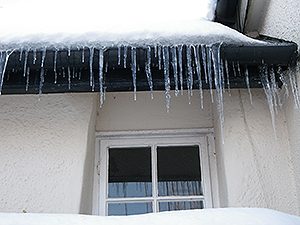Homeowners have a responsibility to ensure their home is in the best possible condition; this is especially true for Landlords of Buy-To-Let properties with tenants. If you haven’t done it already, this is a really good time to make your home and garden are prepared against freezing weather. The checklist below identifies some quick jobs that will help prepare your property for the colder months and save money and energy. After all, they do say ‘prevention is better than cure’.
Outside areas
- Before the on-set of stormy weather, the first and most important area for attention is your roof. Often you can assess whether tiles have moved or are missing from the ground.  Areas of roof that are not easily visible from the ground may require secured access, such as scaffolding, for a closer inspection.
- As autumn advances into winter, leaves and moss can gather and cause blockages in guttering, which can lead to water ingress. Check and clear gutters thoroughly throughout the season.

- It is also important to clear guttering after a snowfall. Leaves and moss can freeze, block or break pipes, or weigh down your guttering causing it crack.
- Equally important is the damage that can be caused by low hanging tree branches in high winds. If you have trees, make sure these are trimmed, preferably by a professional tree surgeon, before bad weather hits.  Generally, October and November are the best times for cutting back trees; a professional tree surgeon will advise you the best time of year to cut back your tree dependent on the type. It is vital to remember that if the branches belong to a tree growing in your neighbour’s garden, it is advisable to speak with them first to avoid disputes should the worst happen.
- To prevent them getting damaged, or from damaging parts of your property in a storm or high winds, loose items in your garden or on a balcony will either need to be brought inside or secured.
Inside your home
- Valuable heat can escape through gaps in doors and windows. Low cost solutions, like adhesive tapes around door and windows frames, as well as old fashioned draught excluders at the foot of doors are simple and effective ways of immediately reducing heat loss and saving money.
- If you have an open fire, when not in use close the flue door to prevent draughts. Remember to open it again when starting a fire and ensure sure you have proper ventilation.
- The more insulated your home, the more heat efficient it is. Good loft insulation is essential and cavity wall insulation also helps. These do not necessarily have to be expensive. There are a number of Government grants that can contribute to the costs and your local authority will be able to advise what funding may be available.
- It is also important to insulate the top and sides of your water tank with sheets, old blankets or a tank jacket.
- To prevent the disruption and inconvenience that frozen water pipes cause, pipes should be lagged with foam tubing to help stop them from freezing. It is particularly important to lag pipes in attics and any leading to outdoor water sources.
- During a cold snap, always keep an eye on pipes for signs of freezing, cracks, bursts or leaks.
- Check dripping taps and fix as even a trickle of water can freeze and completely block a pipe.
- Improve the efficiency of your radiators by ‘bleeding’ them to release trapped air as this will enable hot water to fill every part of the radiator and heat your home more efficiently.
- If you are likely to be absent from your home for more than five days between November and March, you will need either to keep your home constantly heated to 12 degrees centigrade or turn the water supply off at the mains and drain the system.  It is worth noting that in the event of a claim most insurers do not pay out if you have not taken either of these measures.
- And finally, it is vital you know the location of your stop tap so you can reach it quickly in an emergency.  Make a point of finding out where it is as soon as you move into a property (tip: first place to try is beneath the kitchen sink).
© www.propertysurveying.co.uk

